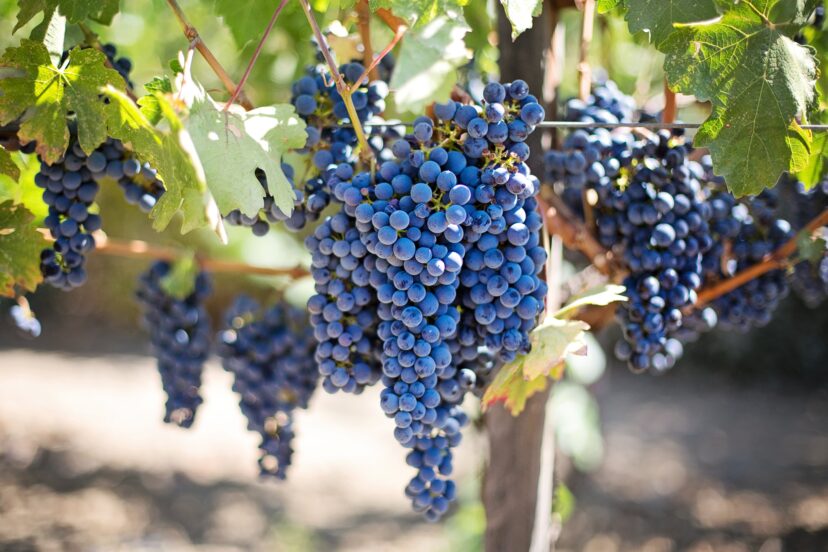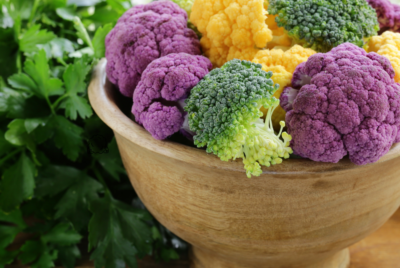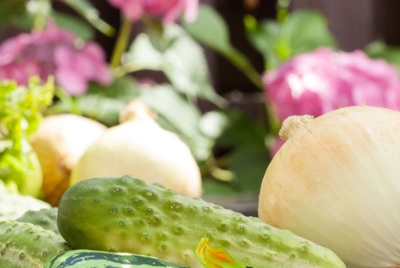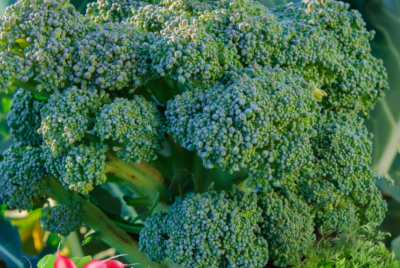Companion Plants for Grapes

Companion Plants for Grapes
I. Introduction
This post is written mainly about backyard grape growing although vineyard grape growing will be addressed in another post.
Hello fellow gardeners and grape enthusiasts! As someone deeply passionate about backyard grape gardening, I’m thrilled to share a slice of my world with you, especially about a technique close to my heart – companion planting. This approach has transformed my grape-growing experience, and I believe it can do wonders for yours too!
Companion planting, at its core, is about creating a harmonious garden where plants support and enhance each other’s growth. It’s like having your personal team of natural helpers, each bringing something special to the table – or, in this case, to the vine. For us backyard grape growers, this means healthier vines, a more vibrant garden, and of course, delicious grapes.
The concept of companion planting is rooted in the idea that certain plants, when grown together, can mutually benefit one another. This could be through pest control, nutrient sharing, or even just providing physical support. Imagine a garden where flowers deter pests naturally, herbs enhance the flavors of your grapes, and every plant plays a role in creating a more productive and sustainable ecosystem. That’s the magic of companion planting!
So, whether you’re a seasoned grape grower or just starting, let’s dive into this fascinating world together. I’ll share insights, tips, and some personal experiences that will help you transform your backyard grape garden into a thriving, fruitful haven. Let’s grow together!
II. Understanding Companion Plants (for Grapes)
When it comes to elevating our backyard grape gardens, understanding the basics of companion planting is key. This age-old gardening practice is all about strategic plant partnerships. It’s like matchmaking for plants – finding the perfect companions that can live together in harmony, each bringing unique benefits to the relationship.
1.Basics of Companion Planting
At its simplest, companion planting involves placing certain plants in close proximity because they can enhance each other’s growth or protect each other from pests. This concept isn’t new; it has been used for centuries in various agricultural practices around the world. For instance, Native American communities practiced the “Three Sisters” method, where corn, beans, and squash were grown together for mutual benefit. Corn provides a structure for the beans to climb, beans fix nitrogen in the soil, and squash acts as a living mulch, suppressing weeds and retaining soil moisture.
In a backyard grape garden, companion planting can take various forms. It could be about planting certain flowers that attract beneficial insects, herbs that naturally repel pests, or other fruits and vegetables that contribute to the overall health of the soil and vines.

2.Benefits for Grapes
The benefits of companion planting in grapes are numerous:
a. Natural Pest Control
Some plants can repel harmful insects or attract beneficial predators, reducing the need for chemical pesticides. For example, planting chives around grapevines can help keep aphids at bay.
b. Improved Soil Health
Certain companions, like legumes, can fix nitrogen in the soil, enriching it and making it more fertile for grapevines. Others can help in maintaining soil structure and moisture levels.
c. Disease Prevention
Companion plants can help prevent diseases by improving air circulation around the vines or by acting as a barrier to fungal spores.
d. Enhanced Grape Quality
Believe it or not, the right companions can actually influence the taste and quality of your grapes. They do this indirectly by creating a healthier environment and directly through subtle changes in soil chemistry.
e. Biodiversity
A diverse garden is a healthy garden. Companion planting encourages a variety of plants and insects, leading to a more balanced and resilient ecosystem.
f. Aesthetic Value
Let’s not forget, a garden with a mix of plants is visually appealing. The combination of grapevines with flowering companions can create a stunning display in your backyard.
Understanding and applying companion planting in your grape garden can lead to a more productive, sustainable, and enjoyable gardening experience. It’s a way to work with nature, rather than against it, to create a thriving backyard vineyard.
III. Selecting the Best Companion Plants for Grapes
Choosing the right companions for your grapevines can make a significant difference in your garden’s health and productivity. While there’s a wide range of plants that can be paired with grapevines, focusing on the ones that provide specific benefits is key. Let’s explore some of the ideal flowers, herbs, vegetables, and fruits that can be your grapevines’ best buddies.
1.Ideal Flowers and Herbs for Grapes

a. Marigolds
These vibrant flowers are not just pretty to look at; they are excellent at repelling nematodes and other soil pests that can harm grape roots.
b. Basil
Known for its strong aroma, basil repels a range of insects and can enhance the flavor of your grapes. It’s a win-win in terms of pest control and potentially influencing grape quality.
c. Lavender
This herb not only adds beauty and fragrance to your garden but also attracts pollinators and beneficial insects that can keep pest populations in check.
d. Chives
Planting chives around grapevines can help repel pests like aphids and mites. Plus, they’re a handy herb to have in the garden for cooking!
e. Rosemary
Known for its strong scent, rosemary can deter pests and is particularly useful in protecting young grapevines.
2.Compatible Vegetables and Fruits
a. Garlic
Planting garlic around grapevines can help deter pests with its strong scent. It’s also believed to improve the flavor of grapes and increase their resistance to fungal diseases.
b. Beans
As nitrogen-fixers, beans are great for enriching the soil. They can enhance the growth and health of grapevines by improving soil fertility.
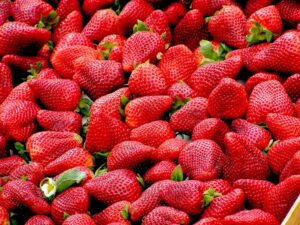
c. Strawberries
These can act as a living mulch, keeping the soil moist and cool. Strawberries also help in weed control and can be a delicious addition to your garden.
d. Squash
The broad leaves of squash plants provide ground cover, helping to maintain soil moisture and suppress weeds.
In choosing companions for your grapes, consider factors like the local climate, soil type, and how much space each plant needs. It’s important to ensure that your companion plants don’t compete with your grapevines for nutrients, water, or sunlight. Proper placement and spacing are crucial for a harmonious and productive garden.
With the right companions, your grapevines can thrive, yielding better quality grapes while also enhancing the overall health and beauty of your garden. Happy planting!
IV. Natural Pest Control with Companion Plants for Grapes
One of the most rewarding aspects of companion planting is its ability to manage pests naturally. This approach can minimize the need for chemical pesticides, fostering a healthier and more eco-friendly garden. Let’s delve into how certain plants can keep pests at bay and attract beneficial insects to your grapevines.
1.Plants that Repel Pests
a. Lavender
This delightful herb not only adds a soothing fragrance to your garden but also is effective in repelling moths, fleas, and flies. Planting lavender near grapevines can help keep these pests away.
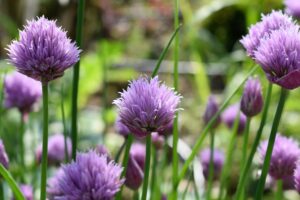
b. Chives
Known for their onion-like scent, chives are great at deterring aphids and mites, common pests that can affect grapevines.
c. Mint
While mint needs to be contained due to its invasive nature, it’s excellent at repelling a variety of insects, including ants and aphids.
d. Oregano
This herb not only enhances your pasta sauce but also repels many pests that are harmful to grapevines. Its strong aroma is not favored by many garden pests.
e. Garlic
Garlic is known for its strong smell, which is effective in repelling insects like aphids and beetles. Interspersing garlic among grapevines can serve as a natural pest deterrent.
2.Attracting Beneficial Insects
a. Marigolds
These bright flowers are not just for show. They attract ladybugs and other beneficial insects that feed on grapevine pests.

b. Dill
Dill attracts wasps and other predatory insects that can control populations of harmful pests. It’s a great companion for grapevines, especially for organic gardening enthusiasts.
c. Borage
Known for its beautiful blue flowers, borage attracts bees and other pollinators, as well as predatory insects that can help manage pest populations.
d. Yarrow
This plant is a magnet for ladybugs and hoverflies, which are natural predators of many common grapevine pests.
e. Sunflowers
Tall and stately, sunflowers not only add height and beauty to your garden but also attract a variety of beneficial insects that can aid in pest control.
Implementing these companion plants in your garden can create a natural defense system against pests, reducing the need for chemical interventions. This approach not only protects your grapevines but also contributes to a healthier and more balanced ecosystem in your backyard. Remember, a diverse garden is a resilient garden, and by welcoming these plants and their insect allies, you’re fostering a vibrant and productive grape-growing environment.
V. Improving Soil Health and Nutrition with Companion Plants for Grapes
1.Enhancing Soil Health
A healthy soil is the foundation of a thriving garden, and this is especially true for grapevines, which are particularly sensitive to the soil environment. Companion planting offers a natural and effective way to improve soil health, thereby ensuring your grapevines have the best growing conditions. Let’s look at how certain companion plants can contribute to soil improvement and help maintain optimal soil moisture and pH balance.
Companion Plants for Soil Improvement
a. Legumes (Beans and Peas)
Legumes are natural nitrogen-fixers, meaning they have the unique ability to convert atmospheric nitrogen into a form that plants can use. Planting legumes in your grape garden can enrich the soil with this essential nutrient, promoting healthier and more vigorous grapevines.
b. Cover Crops (Clover, Alfalfa)
Cover crops are planted not for harvesting but for soil improvement. They help in preventing soil erosion, suppressing weeds, and adding organic matter to the soil when they decompose. Clover and alfalfa are excellent choices for grapevines, as they also fix nitrogen in the soil.
c. Comfrey
Known for its deep roots, comfrey is excellent at mining nutrients from deep within the soil and making them available to other plants. When used as a green manure or mulch, comfrey can significantly improve soil fertility.
2.Maintaining Soil Moisture and pH Balance

a. Mulching Plants (Strawberries, Squash)
Plants like strawberries and squash can act as living mulch. They cover the soil, reducing water evaporation and helping maintain consistent soil moisture levels. This is particularly beneficial during hot, dry periods.
b. pH Modifying Plants
Some plants can alter the pH of the soil slightly through their root exudates. For instance, plants like blueberries that prefer acidic soils can lower the pH over time, which might be beneficial in areas with alkaline soils. However, it’s essential to monitor and maintain the pH within the range suitable for grapevines.
c. Green Manures
Green manures are plants grown to be incorporated back into the soil. They improve soil structure, increase organic matter content, and enhance moisture retention. Plants like buckwheat and ryegrass are often used as green manures in vineyards.
Incorporating these companion plants into your grape garden can lead to a richer, healthier soil, which in turn supports robust grapevine growth. It’s a sustainable way to nourish your soil without relying heavily on chemical fertilizers. By enhancing the soil naturally, you’re not only benefiting your grapevines but also contributing to the overall health of your garden ecosystem.
VI. Disease Prevention with Companion Plants for Grapes
One of the critical challenges in grape gardening is managing diseases, particularly fungal infections that thrive in damp, poorly ventilated conditions. Companion planting offers a natural approach to disease prevention, reducing the risk of such ailments and promoting healthier grapevines. Here’s how companion planting can be instrumental in disease management:
1.Reducing the Risk of Fungal Diseases
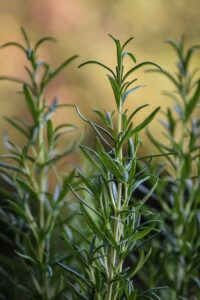
a. Aromatic Herbs (Rosemary, Thyme, Sage)
These herbs are not just culinary delights; they possess natural antifungal properties. When planted near grapevines, they can help suppress fungal spores in the surrounding air and soil, reducing the risk of diseases like powdery mildew and downy mildew, common in grapevines.
b. Mustard
Planting mustard as a cover crop can be beneficial. When incorporated into the soil, mustard acts as a biofumigant, releasing compounds that can suppress soil-borne pathogens and reduce the prevalence of soil-borne diseases.
c. Onion and Garlic
Both of these plants have strong antifungal properties. Interspersing garlic and onions among grapevines can help reduce fungal infections thanks to their sulfur-containing compounds.
2.Promoting Healthy Air Circulation
a. Strategic Planting
The way you arrange your plants can significantly impact air circulation. Ensure that companion plants don’t overcrowd the grapevines. Adequate spacing allows for better airflow, which is crucial in keeping the leaves dry and less susceptible to fungal diseases.
b. Tall, Airy Companions (Sunflowers, Dill)
Plants like sunflowers and dill, when placed strategically, can actually help improve air circulation around grapevines. They attract beneficial insects and don’t create a dense canopy that could trap moisture around the grape leaves.
c. Pruning and Training
While not a plant, the practice of pruning and training companion plants and grapevines is vital. Keeping companion plants well-pruned ensures they don’t overshadow grapevines or inhibit air flow, thus reducing the humidity around grape leaves and stems.
Implementing these companion planting strategies can be a game-changer in managing diseases in your grape garden. It’s about creating an environment that’s less conducive to diseases and more favorable for healthy growth. By thoughtfully selecting and positioning companion plants, you can significantly reduce the prevalence of fungal diseases and enjoy a more bountiful, disease-free grape harvest. Remember, prevention is always better than cure, and with companion planting, you’re taking a proactive step towards healthier grapevines.
VII. Maximizing Vineyard Space Efficiency
Maximizing space is a common challenge for many backyard gardeners, especially when growing space-demanding plants like grapevines. Fortunately, companion planting offers innovative solutions like intercropping and vertical planting to make the most of your available space. Let’s explore these techniques that are perfect for small gardens.
1.Intercropping Techniques

a. Planting Between Rows
Utilize the space between grapevine rows by planting smaller, beneficial plants. For instance, herbs like basil or chives can be grown between grapevines. They don’t take up much space and provide the added benefits of pest control and improved soil health.
b. Succession Planting
This involves planting crops in succession to ensure continuous use of space. After harvesting a short-season crop like lettuce or spinach, you can plant another round of crops or even a different species that will mature before the grapevines fully leaf out.
c. Companion Planting with Low-Growing Crops
Consider planting low-growing crops like strawberries or certain types of squash. These plants spread across the ground, utilizing the horizontal space without competing with the grapevines for vertical space.
2.Vertical Companion Planting

a. Using Trellises and Supports
Vertical gardening is an excellent way to grow more in less space. Plant climbing plants like peas or beans near the base of grapevine trellises. They can climb up the trellis without hindering the growth of the grapevines, as long as they’re managed and pruned properly.
b. Hanging Planters
For really tight spaces, consider using hanging planters for small herbs and flowers. These can be hung from the edges of trellises or other structures, adding beauty and functionality without taking up ground space.
c. Tall but Slim Plants
Some plants grow tall without a wide spread, such as certain varieties of sunflowers or dill. These can be strategically placed to add vertical interest and attract beneficial insects without taking up too much horizontal space.
Incorporating these space-saving techniques allows you to enjoy the benefits of companion planting even in a small garden.
Intercropping and vertical planting not only optimize your garden space but also create a diverse and productive environment for your grapevines.
By thinking creatively and planning your garden layout carefully, you can turn even the smallest of spaces into a lush, fruitful grape haven.
VIII. Adapting to Different Climates
Grapevine gardening is as much about adapting to your local climate as it is about caring for the plants themselves. Companion planting offers a flexible approach, allowing you to select plants that thrive in your specific climatic conditions and benefit your grapevines. Let’s explore how to choose companion plants based on climate and their regional adaptability.

1.Climate-Specific Companion Plants
a. For Cooler Climates
Hardy Herbs – Plants like thyme and sage can withstand cooler temperatures and can help protect grapevines from cold winds.
Root Vegetables – Carrots and beets can be good companions, as they can tolerate cooler soils and help break up the earth, improving soil structure.
b. For Warmer Climates
Drought-Tolerant Plants – Consider drought-resistant companions like lavender and rosemary, which thrive in warm climates and require less water.
Sun-Loving Flowers – Plants like marigolds and sunflowers can endure and even thrive in hotter conditions, providing shade and attracting beneficial insects.
2.Regional Adaptability
a. Understanding Local Soil and Weather Patterns
It’s crucial to be aware of your region’s soil type and weather patterns. Some plants might be better suited to sandy soils and dry conditions, while others prefer clay soils and higher humidity.

b. Local Pest and Disease Considerations
Choose companion plants that are effective against local pests and diseases. For instance, if a certain pest is prevalent in your area, plant companions known for repelling that specific pest.
c. Indigenous Plant Species
Incorporating native plants can be a wise decision. They’re already adapted to the local climate and soil conditions and can often provide the best support for your grapevines.
d. Experimentation and Observation
Gardening is a continuous learning process. Experiment with different plants and observe which ones perform best in your garden. Local gardening communities and nurseries can be great resources for advice on what works well in your area.
e. Seasonal Planting
Pay attention to the growing seasons of both your grapevines and their companions. Some plants might be ideal for spring planting, while others could be more suitable for the summer or fall.
By carefully selecting companion plants that are well-suited to your local climate and conditions, you can create a more resilient and productive grape garden. This regional adaptability not only ensures the health of your grapevines but also contributes to a more sustainable and environmentally friendly gardening practice. Remember, the best garden is one that exists in harmony with its natural surroundings.
IX. Boosting Grape Quality for Consumption
One of the ultimate goals of backyard grape gardening is not just to grow grapes, but to cultivate them in a way that enhances their flavor and nutritional value. Companion planting can play a significant role in achieving this goal. The right companions can influence the quality of the grapes, making them not just more delicious but also more nutritious.
1.Impact on Grape Flavor
a. Herbs and Aromatic Plants
Some herbs and aromatic plants, when planted near grapevines, can subtly influence the flavor profile of the grapes. For instance, planting basil or mint nearby might impart a slight, nuanced change in the grape’s taste, adding a layer of complexity to the fruit.
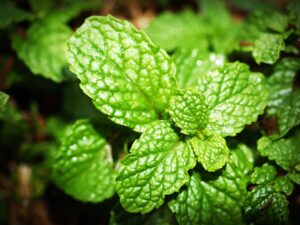
b. Soil Health and Quality
The health and quality of the soil directly impact the taste of the grapes. Companion plants like legumes improve soil fertility by fixing nitrogen, leading to richer, more flavorful grapes.
c. Pest and Disease Management
Healthy vines produce better-quality grapes. Companion plants that help manage pests and diseases naturally lead to healthier grapevines and, as a result, better-tasting grapes.
2.Enhancing Nutritional Value
a. Increased Biodiversity
A diverse garden ecosystem, encouraged by companion planting, can lead to a more nutrient-rich soil. This diversity can increase the uptake of various minerals and nutrients by the grapevines, enhancing the nutritional value of the grapes.
b. Natural Growth Promotion
Companion plants that promote natural growth and health of the grapevines (like nitrogen-fixing plants or those attracting beneficial insects) ensure that the grapes develop optimally, packed with natural goodness.
c. Reduced Chemical Use
By minimizing the need for chemical pesticides and fertilizers through natural gardening practices like companion planting, the grapes grown are likely to be healthier and free from potential chemical residues.
Incorporating companion planting into your grape garden is not just about growing grapes; it’s about growing them in a way that maximizes their taste and health benefits. The nuanced changes brought about by this method can elevate the quality of your homegrown grapes, making each bite a testament to the power and harmony of nature in your backyard. Remember, the best-tasting and most nutritious grapes are the result of a balanced and healthy garden ecosystem.
X. Implementing Companion Plants for Grapes: Practical Advice
Embarking on the journey of companion planting in your grape garden can be an exciting and rewarding experience. To help you get started, I’ve put together some practical advice and a step-by-step guide to implementing companion planting effectively. Additionally, I’ll share some layout and design tips to ensure your garden is not only productive but also aesthetically pleasing.
1.Step-by-Step Implementation Guide
a. Assess Your Space
Begin by evaluating the space available in your garden. Consider the size of your grapevines at maturity and the space needed for companion plants.

b. Research and Select Companions
Based on your local climate, soil type, and specific garden conditions, choose companion plants that will benefit your grapevines. Focus on plants that offer pest control, soil improvement, or disease prevention.
c. Plan Your Layout
Sketch a layout of your garden, placing grapevines and companion plants in a way that optimizes space and sunlight exposure. Ensure there’s enough room for each plant to grow without overcrowding.
d. Prepare the Soil
Before planting, prepare your soil. This might involve adding organic matter, adjusting pH levels, or simply loosening the soil to improve aeration and drainage.
e. Planting
Plant your grapevines and companion plants according to the layout you’ve planned. Pay attention to the specific planting needs of each species (depth, spacing, etc.).
f. Ongoing Care
Companion planting doesn’t end with planting. Regularly monitor your plants for health, growth, and signs of pests or diseases. Prune and maintain as needed to ensure proper air circulation and exposure to sunlight.
2.Layout and Design Tips

a. Aesthetic Considerations
Balance functionality with aesthetics. Arrange plants in a way that is pleasing to the eye, perhaps creating patterns or color contrasts with flowering companions.
b. Accessibility
Ensure that all plants are easily accessible for maintenance. Leave pathways or spaces between plantings for easy access.
c. Companion Height and Spread
Consider the mature height and spread of your companion plants. Taller plants should be positioned so they don’t shade your grapevines, while ground covers should be placed where they won’t encroach on other plantings.
d. Companion Diversity
Mix up your plant types. A combination of flowers, herbs, and even certain vegetables can create a diverse ecosystem that benefits your grapevines and enhances the overall health of your garden.
e. Seasonal Planning
Think about how the garden will change with the seasons. Some companions might be annuals, while others are perennials. Plan for how the garden will look and function throughout the year.
Implementing companion planting in your grape garden is a dynamic process that requires patience and experimentation. It’s about learning what works best for your specific environment and adjusting as needed. With thoughtful planning and care, your companion-planted grape garden will not only be a source of delicious fruits but also a place of natural beauty and ecological balance.
XI. Avoiding Common Mistakes with Companion Plants for Grapes
While companion planting offers numerous benefits, it’s also easy to make mistakes that can hinder your garden’s success. Understanding and avoiding these common pitfalls will ensure that your grapevines and their companions thrive together. Let’s explore some of the key mistakes to avoid, particularly focusing on incompatible plant pairings and issues related to overcrowding and resource management.
1.Incompatible Plant Pairings
a. Ignoring Plant Compatibility
Not all plants get along. Some plant combinations can be detrimental to one or both of the plants involved. For example, planting grapes near walnut trees can be harmful, as walnuts produce juglone, a compound toxic to many plant species.
b. Allelopathic Effects
Some plants, like fennel, release substances that can inhibit the growth of surrounding plants. Be aware of such allelopathic interactions when choosing companion plants.
c. Competing Growth Requirements
Avoid pairing plants with drastically different needs. For instance, water-loving plants should not be paired with those preferring dry conditions, as this can create a conflict in watering practices.
2.Overcrowding and Resource Management

a. Space Management
Overcrowding can lead to competition for sunlight, water, and nutrients, which can stress the plants and make them more susceptible to diseases and pests. Ensure each plant has enough space to grow to its full potential.
b. Water and Nutrient Competition
Be mindful of the water and nutrient needs of your grapevines and companion plants. Some companions may have higher water or nutrient demands, which could deprive your grapevines of these essential resources.
c. Light and Air Circulation
Proper air circulation is vital for preventing fungal diseases in grapevines. Avoid planting companions too close to your vines, which can impede air flow and reduce sunlight exposure, creating damp, shadowy conditions conducive to disease.
d. Root Competition
Deep-rooted plants can compete with grapevines for nutrients and water at lower soil levels. Opt for shallow-rooted companions to avoid this issue.
To successfully implement companion planting in your grape garden, it’s crucial to research and plan ahead. Understanding the specific needs and characteristics of your grapevines and their potential companions will help you create a harmonious and productive garden. Remember, companion planting is not just about putting plants together; it’s about creating a balanced ecosystem where each plant supports the others, leading to mutual growth and health.
XII. Conclusion: Embracing Companion Plants for Grapes
As we reach the end of our exploration into the world of companion planting for grapevines, it’s clear that this practice is much more than just a gardening technique. It’s a holistic approach to cultivating a thriving, vibrant, and productive garden. Let me share some final thoughts and reflections on this journey.

a. Summary
Companion planting is an art that harmonizes different plants for mutual benefit. It’s about strategically selecting and placing plants to enhance grapevine health, control pests naturally, improve soil quality, and manage diseases. From selecting the right companion plants like marigolds for pest control and legumes for soil health, to considering important factors like plant compatibility and resource management, companion planting offers a sustainable path to a healthier garden.
b. Personal Reflection
As a grapevine enthusiast, embracing companion planting has been a transformative experience. It has taught me the value of observing and working with nature, rather than against it. Seeing the way different plants support each other, enhance each other’s growth, and contribute to a more balanced ecosystem has been incredibly rewarding. It’s not just about the quantity or quality of the grapes but about fostering a garden that thrives in harmony with nature.
c. Encouraging Sustainable Practices
Companion planting is more than just a method for growing grapes; it’s a step towards sustainable gardening practices. By reducing the need for chemical inputs and creating a more self-sustaining environment, companion planting aligns with the principles of ecological balance and sustainability. It’s a practice that resonates with the current need for more environmentally friendly approaches in all aspects of life, including gardening.
In conclusion, whether you’re a seasoned gardener or just starting out, I encourage you to try companion planting in your grape garden. It’s an approach that promises not just a bountiful harvest but also a deeper connection with the natural world. Embrace the diversity, the challenges, and the joys that come with companion planting, and watch as your garden transforms into a more productive and harmonious space. Happy gardening!
FAQs about Companion Plants for Grapes
1.What are the best companion plants for grapes?
The best companion plants for grapes include marigolds for pest control, basil to enhance grape flavor, legumes like beans and peas to enrich the soil with nitrogen, and garlic for its pest-repelling properties and potential disease resistance benefits. These plants not only support grapevine health but also contribute to a diverse and balanced garden ecosystem.
2.Can companion planting really improve the quality of grapes?
Yes, companion planting can significantly improve the quality of grapes. By enhancing soil health, providing natural pest control, and creating a balanced ecosystem, the vines grow healthier, leading to better-tasting and more nutritious grapes. The right companions can subtly affect the grape’s flavor profile and overall vine vigor.
3.How does companion planting help in controlling pests naturally?
Companion planting controls pests by attracting beneficial insects and repelling harmful ones. For example, plants like lavender and chives attract pollinators and beneficial predators, while marigolds and garlic repel common pests like aphids and beetles. This natural balance reduces the need for chemical pesticides.
4.What should I consider when planning my companion planting layout?
When planning your companion planting layout, consider the specific needs of each plant in terms of sunlight, water, and space. Ensure that companion plants do not overshadow grapevines or compete excessively for resources. Also, consider the compatibility of plants to avoid allelopathic effects and choose plants that complement the growth and health of grapevines.
5.Are there any risks associated with companion planting in vineyards?
The main risks involve choosing incompatible plant pairings that may compete for resources or harm each other, and managing space to prevent overcrowding. To mitigate these risks, carefully research plant compatibilities and plan your garden layout to ensure each plant has enough space and resources to thrive. Regular monitoring and maintenance are also crucial to address any issues promptly.

Companion Plants for Sunflowers
Growing Tangerine Trees in Containers

